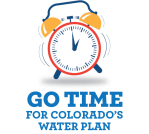
The final draft of Colorado’s Water Plan (CWP) was released in December 2015. In our 2016 Headwaters magazine series on the plan’s implementation, the Colorado Foundation for Water Education keeps you up to speed on how the plan’s action steps are progressing on the ground. Find past installments of the series in the Winter 2016 and Summer 2016 issues of Headwaters. You can also check them out on the Your Water Colorado blog via these links: Meeting the Plan’s Conservation Goals; Environmental and Recreational Goals; Storage Goals; Funding Goals; and Land Use Goals. Here we take an in-depth look at another of the plan’s nine defined measurable outcomes: outreach, education, and public engagement.
____________________________________________________
By Meagan Webber
Even though all Coloradans have unique backgrounds, perspectives and experiences, our common dependence on clean, reliable water sources makes us all stakeholders in the efforts to close Colorado’s projected water supply gap.
“Education, outreach and public engagement are the gateway to get citizens involved in the conversation, and hopefully actively engaged in water management at the local and state level,” says Mara MacKillop, public engagement specialist for the Colorado Water Conservation Board (CWCB). “Every Coloradan has a role to play in our water future and we need to give them the tools and information to participate, which is what Colorado’s Water Plan aims to do.”
In Section 9.5, which is devoted to outreach, education and public engagement, the water plan lays out a three-step approach to helping more Coloradans get informed and make water-savvy decisions. “This is exactly what the Colorado Foundation for Water Education is all about,” says Jayla Poppleton, CFWE Content Program Manager and Headwaters Senior Editor. “And we believe we’re positioned to play a leading role in helping the CWCB and water educators throughout the state achieve the plan’s education outcomes.”
The first of the action steps outlined in Colorado’s Water Plan is to create a new Education and Public Engagement Grant Fund in order to set money aside specifically for water education. The Water Supply Reserve Account (WSRA) is one of the main sources of funding for education, outreach and public education initiatives focused on Colorado’s water. However, due to the Colorado Supreme Court’s ruling on the BP America vs. Colorado Department of Revenue case this past April, WSRA will not receive additional funding in the 2016-17 fiscal year. This means that basin roundtable accounts will also not receive additional funding and will have to rely upon their current balances to fund educational efforts. Thus, the CWCB has had to find creative ways to bridge this funding gap. The new grant fund would be part of the CWCB Water Projects Bill that has been in the works this summer. “If the bill passes, then on July 1, 2017, the new Education and Public Engagement Grant Fund will be ready to go. The framework is here but we have to wait to see what the legislature passes,” MacKillop says.
In the event that the fund is approved, the CWCB will be prepared. Under the Interbasin Compact Committee (IBCC), the Public Education, Participation and Outreach (PEPO) workgroup will be hosting a workshop in October 2016 for liaisons from the basin roundtables to determine guidelines and criteria for dispersal of funds.

Vicki Phelps helps with a watershed education outreach class for young children at the San Miguel River Colorado, July 6, 2015. Photo by Matt Nager
The second action step is the creation of a data-based water education plan. Before this water education plan can be developed, it’s crucial to assess current initiatives, looking for existing gaps in water education and ways to make successful programs replicable and scaleable. This is what the Water Education Assessment aims to do. The CWCB and Colorado Foundation for Water Education (CFWE) along with other groups have been collaborating to flesh out the assessment. These groups also seek to incorporate more significant evaluation aspects into water education programs to collect baseline data on what has been working and build from there, learning from the feedback all the while. This effort is still in its initial stages and will be developed further over the next few months, eventually leading to the creation of the proposed education plan.
The final action step is to improve the use of existing state resources. Part of this involves working with the Colorado Innovation Network (COIN) to find creative solutions to Colorado’s water challenges. This collaboration has already begun with initial conversations and a budding partnership between the CWCB and COIN. They are working on identifying specific challenges that COIN can help tackle. “It’s exciting to bring creative innovation into our water world,” MacKillop says.
Another part of this is to improve coordination between state agencies on outreach and education activities so that everyone is one the same page when it comes to Colorado water education. The communications committee of the CWCB is working on developing performance metrics and a corresponding database to let the public know about progress in implementing the water plan. They have also started issuing the CWCB Confluence Newsletter to keep Coloradans up-to-date on implementation. The first issue came out in August 2016 and bimonthly newsletters will follow, covering everything from Basin Implementation Plans (BIPs) to current CWCB activities.
“Water education, outreach, and public engagement are essential to effectively and fully implement Colorado’s Water Plan,” MacKillop says. “Which ultimately means meeting our state’s future water needs, protecting our state’s values, and enhancing the long-term vitality and prosperity of Colorado.”

 Print
Print
Reblogged this on Coyote Gulch.